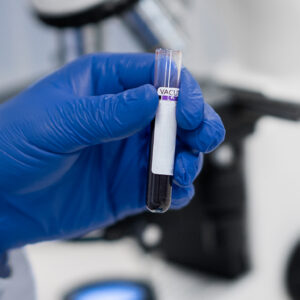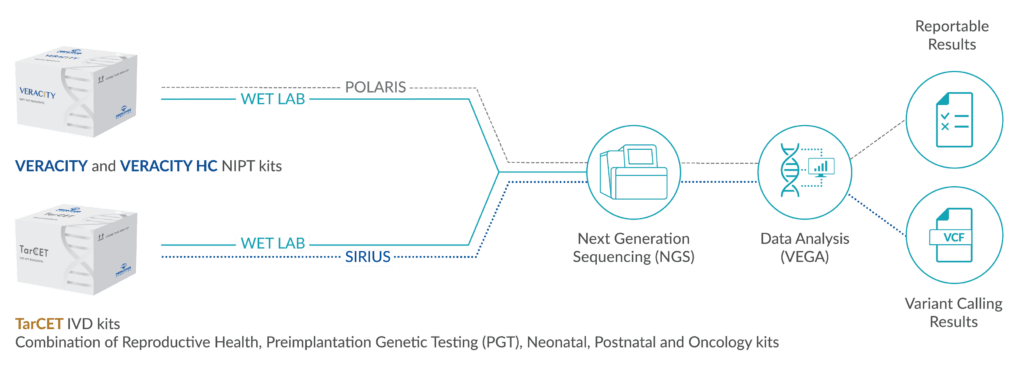Scientific Background
Primary hypertriglyceridemias (hyperlipidemia type IV according to the Fredrickson classification) can be divided as follows:
- Familial hypertriglyceridemia is a mild to moderate form with triglyceride levels up to 500 mg/dl (5.65 mmol/l) and often with low HDL cholesterol. The risk of atherosclerosis is not increased if no other risk factors are present. Genetic causes are not yet known.
- In mild to moderate hypertriglyceridemia, triglyceride levels range from about 200 mg/dl to about 900 mg/dl. It can be based on a heterozygous gene alteration that causes a phenotype or on the cumulative effect of several gene variants that alone have little influence on the phenotype. The latter is a polygenic alteration with secondary triggers possibly involving more than 30 genes.
- Triglyceride levels above 900 mg/dl (> 10 mmol/l) are referred to as severe hypertriglyceridemia. This includes chylomicronemic syndrome. If such high concentrations are detected in childhood or young adulthood (<40 years), a primarily monogenic cause is considered likely. Early atherosclerosis does not develop despite the high triglyceride levels. Here, reducing the risk of pancreatitis is the main focus of therapy.
Chylomicronemia syndrome is a severe hypertriglyceridemia that can be divided into two primary forms: monogenic and polygenic chylomicronemia. Monogenic chylomicronemia is a very rare, autosomal recessive inherited condition of chylomicron metabolism (also called familial chylomicronemic syndrome or hyperchylomicronemic syndrome; formerly type I hyperlipidemia), which occurs in childhood or adolescence. It is often caused by homozygous or combined heterozygous pathogenic variants in the LPL gene or its cofactors APOC2, APOA5, GPIHBP1 or LMF1. These genes play an important role in triglyceride catabolism. The disease is characterized by extremely high serum triglyceride concentrations (up to 30,000 mg/dl) and the serum has a milky-creamy appearance. The diagnosis is usually made in connection with recurrent pancreatitis (differential diagnosis: hereditary pancreatitis). Eruptive xanthomas and hepatomegaly are further frequent clinical manifestations; a history of lactose intolerance in childhood is often reported. The therapy for pancreatic conditions consists of a low-fat diet and alcohol abstinence. In particularly severe cases lipid apheresis is indicated. Secondary causes such as liver and kidney diseases, alcohol abuse, pancreatitis and diabetes mellitus, which can disturb an existing moderate hypertriglyceridemia, should be excluded beforehand. Polygenic chylomicronemia (also called mixed dyslipidemia; formerly type V hyperlipidemia), is known as "late-onset" and occurs more frequently than the monogenic form. It is caused by the accumulation of several genetic factors and the previously mentioned secondary factors can have an additional negative influence on them. Here too, there is an increased risk of pancreatitis and in addition, the polygenic form can also be associated with an increased risk of cardiovascular disease.
The hepatic enzyme lipoprotein lipase (Lpl), which is present on the endothelial cells of extrahepatic capillaries, plays an important role in the hydrolytic degradation of triglyceride-rich lipoproteins, especially chylomicrons. Severe hypertriglyceridemia is caused by homozygous or mixed heterozygous pathogenic variants in the LPL gene (LPL deficiency). Secondary Lpl deficiency can also be caused by pathogenic variants in the APOC2 gene (APOCII deficiency), which is the most important cofactor for Lpl. In other cases, GPIHBP1 gene variants that lead to a defect in the lipoprotein lipase transporter glycosylphosphatidylinositol anchored high density lipoprotein-binding protein 1 (GPIHBP1), as well as LMF1 gene (lipase maturation factor-1) variants that are associated with a combined lipase deficiency, are described. In rare cases, there are variants in the APOA5 gene that are involved in the hydrolysis of triglyceride rich lipoproteins by increasing Lpl activity.
When treating hypertriglyceridemia with fibrates that have an effect via transcriptional activation of Lpl gene expression and can reduce triglycerides by up to 40%, it is important to consider whether a functional LPL allele with residual activity may be present. Determination of Lpl activity in vitro, requires the enzyme to be released from its heparin-sulfate binding sites prior to blood collection (post-heparin Lpl activity). The correct sampling conditions and the immediate freezing of the EDTA plasma sample in dry ice or liquid nitrogen are vital.
Since 2012, a gene therapy with the trade name Glybera (Alipogentiparvovec) has been approved in Europe for certain patients with a genetically determined LPL deficiency. With this treatment, a wild-type copy of the LPL gene is introduced into the nuclei of muscle cells via an adeno-associated viral vector.
References
Blom et al. 2018, J Clin Lipidol 12:1234 / Stroes et al. 2017, Atheroscler Suppl 23:1 / Burnett et al. 2017, GeneReviews® [Internet], www.ncbi.nlm.nih.gov/books/NBK1308/ / Kassner et al. 2017, Der Internist 58:866 / Ramasamy 2016, Clin Chim Acta. 454:143 / Brahm et Hegele 2015, Nat. Rev. Endocrinol 11:352





















